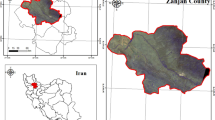Abstract
Due to increasing urbanization, urban growth or sprawl monitoring and measurement is needed in the developing countries like in India. For findings the urban growth and prediction of upcoming possible development of Kolkata city the SLEUTH model is employed. It is one of the most important urban development models which is utilized all over the world. The model was calibrated through the historical past data which are extracted from the satellite images in different time period. Six input data are used in this model such as slope, land use, excluded, urban extent, transportation, and hillshade. All the inputs were derived from the satellite image, and that was classified through the Maximum Likelihood classification technique. In this research, five Landsats temporal data (1978, 1988, 2000, 2010 and 2020) were used for prediction of urban growth of Kolkata City. The historical urban scenario is presented in this study which allowed urban expansion persistence in the previous trend. Calibration results show that the spread coefficient value is high which indicates the future prediction of Kolkata city is edge enlargement. Study revealed that in future more urban expansion may happen from 2020 to 2040 in the north-east and south-east positions of the Kolkata City. Besides, it is also observed that in future in the year of 2040 about 70% of total study area may be occupied by the urban area.
Access this chapter
Tax calculation will be finalised at checkout
Purchases are for personal use only
Similar content being viewed by others
References
Clarke KC, Hoppen S, Gaydos L (1997) A self-modifying cellular automaton model of historical urbanization in the San Francisco Bay area. Environ Plan A 24:247–261
Khamchiangta D, Dhakal S (2019) Physical and non-physical factors driving urban heat island: case of Bangkok Metropolitan Administration, Thailand. J Environ Manage 248:109285
Ranagalage M, Wang R, Gunarathna MHJP, Dissanayake D, Murayama Y, Simwanda M (2019) Spatial forecasting of the landscape in rapidly urbanizing hill stations of south asia: a case study of Nuwara Eliya, Sri Lanka (1996–2037). Remote Sens 11:1743
Keeratikasikorn C, Bonafoni S (2018) Urban heat island analysis over the land use zoning plan of Bangkok by means of Landsat 8 imagery. Remote Sens 10(3)
Estoque R, Murayama Y (2017) Monitoring surface urban heat island formation in a tropical mountain city using Landsat data (1987–2015). ISPRS J Photogramm Remote Sens 133:18–29
Bhatta B (2009) Analysis of urban growth pattern using remote sensing and GIS: a case study of Kolkata, India. Int J Remote Sens 30(18):4733–4746
Kundu K, Halder P, Mandal JK (2020) Urban change detection analysis during 1978–2017 at Kolkata, India, using multi-temporal satellite data. J Indian Soc Remote Sens 48:1535–1554
Jafarnezhad J, Salmanmahiny A, Sakieh Y (2016) Subjectivity versus objectivity: comparative study between Brute Force method and Genetic Algorithm for calibrating the SLEUTH urban growth model. J Urban Plann Dev 142(3)
KantaKumar NL, Sawant NG, Kumar S (2011) Forecasting urban growth based on GIS, RS and SLEUTH model in Pune metropolitan area. Int J Geom Geosci 2(2):568–579
Rafiee R, Mahiny AS, Khorasani N, Darvishsefat AA, Danekar A (2009) Simulating urban growth in Mashad City, Iran through the SLEUTH model (UGM). Cities 26(1):19–26
Clarke KC (2008) Mapping and modelling land use change: an application of the SLEUTH model. In: Landscape analysis and visualisation, pp 353–366
Alsharif AAA, Pradhan B (2014) Urban sprawl analysis of Tripoli Metropolitan City (Libya) using remote sensing data and multivariate logistic regression model. J Indian Soc Remote Sens 42(1):149–163
Aburas MM, Ho YM, Ramli MF, Ash’aari ZH (2016) The simulation and prediction of spatio-temporal urban growth trends using cellular automata models: a review. Int J Appl Earth Obs Geoinf 52:380–389
Author information
Authors and Affiliations
Editor information
Editors and Affiliations
Rights and permissions
Copyright information
© 2021 The Author(s), under exclusive license to Springer Nature Singapore Pte Ltd.
About this paper
Cite this paper
Kundu, K., Halder, P., Mandal, J.K. (2021). Urban Growth Prediction of Kolkata City Using SLEUTH Model. In: Mandal, J.K., Mukhopadhyay, S., Unal, A., Sen, S.K. (eds) Proceedings of International Conference on Innovations in Software Architecture and Computational Systems. Studies in Autonomic, Data-driven and Industrial Computing. Springer, Singapore. https://doi.org/10.1007/978-981-16-4301-9_11
Download citation
DOI: https://doi.org/10.1007/978-981-16-4301-9_11
Published:
Publisher Name: Springer, Singapore
Print ISBN: 978-981-16-4300-2
Online ISBN: 978-981-16-4301-9
eBook Packages: Computer ScienceComputer Science (R0)




